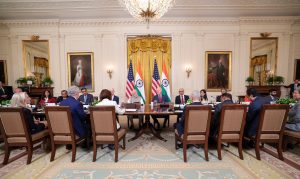During Prime Minister Narendra Modi’s recent state visit to the United States, India inked a landmark defense deal that will see the American conglomerate General Electric (GE) and India’s state-owned Hindustan Aeronautics Limited (HAL) co-produce jet engines in India. The GE deal is an indication of how far the India-U.S. relationship has come over the last two decades and demonstrates that Washington is now willing to supply India with critical defense technologies.
As a rising power, India has sought to bolster its military capabilities. In addition, the ongoing border standoff with China has prompted India to hasten its military modernization efforts. But India’s traditional weapons supplier, Russia, has been constrained by the war in Ukraine. Furthermore, as Russia and China get closer, New Delhi is likely to get increasingly apprehensive about its dependency on Russia for military hardware. Could the United States help India de-risk from Russian arms?
Russia has been India’s preferred military supplier for several decades, and it is estimated that 60-70 percent of its current defense inventory is of Russian origin. India’s military dependence on Moscow can be traced back to the Cold War, when the former Soviet Union offered India favorable conditions for arms transfers. This dependence persisted even after the Cold War ended, as India continued to buy heavily from Moscow. This is because Russian arms remained cheaper than their Western counterparts and carried no end-user constraints. Furthermore, Russia was often willing to provide key defense technologies that the West denied India.
In spite of these benefits, India has increasingly diversified its arsenal over the last two decades. Defense trade with Israel has grown steadily since the turn of the century. France and the United States too have bagged multi-billion-dollar arms contracts of late and emerged as major weapons suppliers.
While India’s military diversification has come at the cost of fewer imports from Russia, Moscow still occupies a lion’s share of India’s arms import bill. Russian arms made up 45 percent of India’s arms imports between 2018 and 2022—a figure that has been brought into focus by the war in Ukraine.
With Russia unable to deliver new weapons or the spares and ammunition that India requires, New Delhi is looking to reduce its reliance on Moscow and has ramped up its efforts to diversify its military equipment. However, it is not seeking to replace its Russian arsenal with a Western one.
Instead, India hopes to diversify through the indigenous design and production of defense equipment. Over the last few years, New Delhi has introduced several reforms to this effect. For instance, India’s new Defense Acquisition Procedure prioritizes procurement from indigenous sources. Additionally, New Delhi has outright banned the import of defense equipment that it believes can be manufactured domestically.
Despite these measures, India is not looking to become self-sufficient in the production of defense equipment in the short term. The focus is instead on tying up with foreign countries and achieving co-production of defense equipment along with the transfer of technology. Here, the United States can play an important role in enabling India’s push for indigenous defense capabilities.
The significance of the recently signed GE deal cannot be understated. It marks the first time Washington is engaging in the co-production of jet engines with a non-treaty ally. What is more, the deal will see GE transferring around 80 percent of the jet engine technology to HAL. Washington has never authorized this level of technology transfer before.
This much-coveted jet engine technology is set to boost India’s indigenous jet engine programs. Moreover, the state-of-the-art GE 414 engines manufactured in India under the deal will power future Indian indigenous fighter aircraft. This includes the Tejas Mk II, the Advanced Medium Combat Aircraft (AMCA), India’s fifth generation fighter, and the Twin Engine Deck Based Fighter (TEDBF), which India is developing for its navy.
Washington’s commitment to enabling India’s indigenous capabilities isn’t limited to jet engines. India and the United States recently agreed upon a roadmap for Defense Industrial Cooperation that aims to bring about technological cooperation and co-production in areas such as air combat and land mobility systems, intelligence, surveillance, and reconnaissance (ISR) platforms, munitions, and undersea domain awareness. If cutting-edge technologies in these areas were to be made available to India, they would further empower India’s indigenous defense capabilities.
Added to this is an American willingness to foster collaboration between the defense industrial ecosystems of the two countries. INDUS-X, a defense innovation bridge launched under the India-U.S. initiative on Critical and Emerging Technologies (iCET) has been set up for this very purpose. At the inaugural INDUS-X summit, the two countries discussed a slew of initiatives such as joint challenges and a joint innovation fund. These could provide a fillip to the innovative technologies being developed by India’s budding defense and space start-up ecosystem.
Overall, it is clear that the United States is keen to wean India off Russian arms and is willing to offer India critical defense technologies. While India is likely locked into using Russian military hardware for decades to come, and may even continue procuring from Russia for the benefit of strategic autonomy, it should seize the opportunity to absorb American technologies where it can. This will allow India to build up its indigenous defense capabilities and take it a step closer to the eventual goal of self-reliance.

































